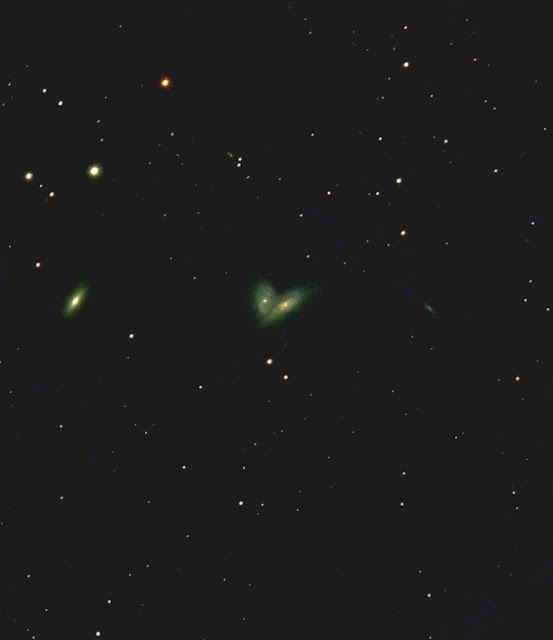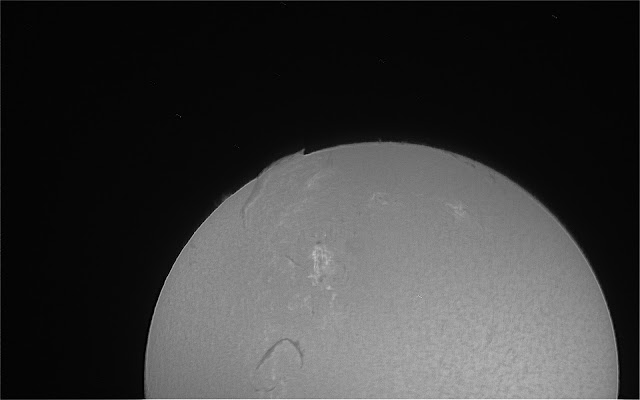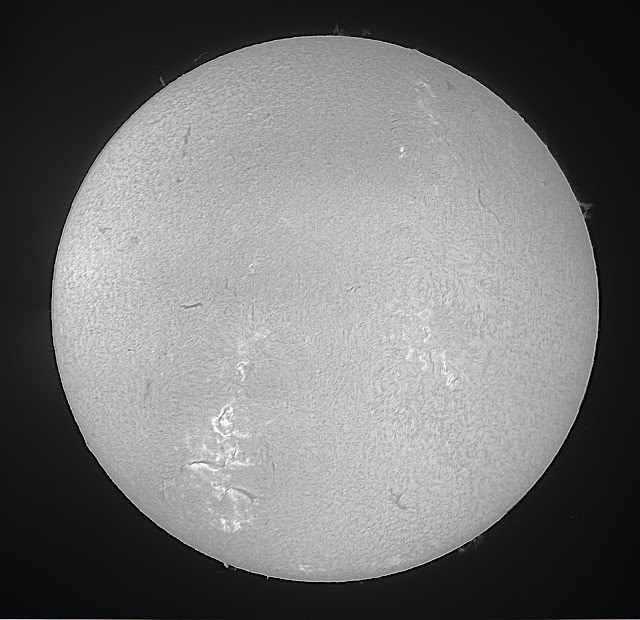Messier 16, the Eagle Nebula, ia an active region of star formation in the constellation Serpens. It's an impossible object from my home observatory due to trees. However, I am visiting family in northern Indiana at a site 36 miles east of downtown Chicago. The skies are surprisingly dark, especially to the south. The portable setup for this trip was a William Optics GT-71 20th anniversary edition with 6A-II FF/FR, a Mallincam DS10C camera with filters, and a very basic iOptron Smart EQ-Pro mount. This image of the Eagle is a stack of 124 integrations captured at 20, 25, and 30s with an L-eXtreme-2 filter. The imaging was unguided and I manually dithered. I decided to do a starless version of the nebula as I'm having trouble adjusting the backfocus on the FF/FR and stars at the edge of the image are distorted. I'm quite pleased with the image, given the very basic imaging setup.
The trials, tribulations and small triumphs of a Charlotte, NC astronomer imaging under Bortle 8/9 skies.
Tuesday, June 28, 2022
Wednesday, June 22, 2022
The Sun on June 22, 2022
AR 3038 continues to be active, but was not flaring when the two panoramas below were captured. There are currently six active areas on the Sun as this solar cycle continues to build. Prominences are visible on both images.
Tuesday, June 21, 2022
AR 3038 on the Solstice (June 21, 2022)
AR 3038 has indeed been flaring and is a very active region. The inverted image below shows plasma knots swirling in the spot's complex beta-gamma magnetic field. The second image is a full disk panorama record of the Sun today. Images taken with a 40mm PST-DS and Mallincam DS2.3+ camera.
Monday, June 20, 2022
Colliding Galaxies--A Rework of The Siamese Twins Galaxies
NGC 4567 and 4568 are unbarred spiral galaxies in Virgo. This image is a very aggressive crop from the larger field image shown in my earlier post on integration times. The image is pixellated as the RASA 8 scope has a very large field and these galaxies are tiny objects in the captured image. It's always fun to capture colliding galaxies from your own back yard :)
Sunday, June 19, 2022
The Sun on June 19, 2022
AR 3038 seems to be flaring in this image. The brightness of the area has declined significantly since this image was taken at 1:20 pm local time (EST) (17:20 UT).
Saturday, June 18, 2022
A Re-Work of Messier 58
Although it is one of the brightest galaxies in the Virgo Cluster, Messier 58 was described by Charles Messier as an extremely faint galaxy that disappeared when he applied the small amount of light needed to illuminate the crosshairs of his telescope. It's small angular diameter makes it a difficult object in the RASA 8, and it is hard to pull much detail out of the galaxy under the CSOs Bortle 8/9 skies. This image is taken from data captured over several nights. The galaxy is visible for a short time in the strip of sky between trees and a house roof. Taken with the RASA 8 and DS10C with L-Pro filter, this image represents 102 minutes of total integration time. The image is cropped from my earlier post on integration times and has been further processed than the image in that post. M58 is an intermediate, barred spiral and was, in Messier's time, the farthest known astronomical object (although it was not recognized as such).
The Sun on June 18, 2022
AR 3031, now approaching the Sun's limb, continues to show potential for M-Class flares. The the other spots appear to have stable magnetic fields. Several prominences are visible today and are captured on the overexposed image. The large filament is 370,000 km long--about the same distance as the Moon is from the Earth. Powerful plasma currents are flowing through it. One end is anchored in AR 3032, the other is not attached to anything, making a powerful CME a possibility if becomes unstable and erupts.
Thursday, June 16, 2022
The Sun on June 16, 2022
AR 3031 continues to pose a threat for flares today. The inverted closeup shows fine detail in this region. AR 3031 is in the middle of the group on the left. To the right is ARs 3030 and 3032, which do not pose a flare threat. The full disk image shows all activity on the sun today.
Wednesday, June 15, 2022
The Sun on June 15, 2022
AR 3031 (in the middle of the large group of active areas left of and just below center), has a "beta-gamma" magnetic field and the potential to produce M-Class flares. The inverted image below was derived from a monochrome solar image colored blue in Affinity Photo, and then inverted. Inversion is a useful technique for showing very fine detail that might be missed on a non-inverted image.
Here's the positive image:
Tuesday, June 14, 2022
The Siamese Twins Galaxies--an experiment in integration times in Bortle 8/9 skies
The Siamese Twins Galaxies (NGC 4567 and NGC 4568) are merging
galaxies with a band of strong star formation where they overlap. They are a difficult
target for the RASA 8/Mallincam DS10C combination because they have a very
small angular diameter in the scope’s FOV.
The astrometric images show a number of interesting galaxies and other
objects.
I decided that these objects provided an opportunity to
examine the effects of increasing exposure times on the quality of an image
under Bortle 8/9 skies. Unfortunately, cloudy weather prevented me from completing
a full series of images, and by the time skies cleared, the imaged field was
behind the roofline of the house by the time skies became dark enough to image.
The imaging system was: RASA 8, DS10C, Optolong L-Pro
filter. Imaging time was 7 seconds per integration at NINA Gain 1000. No binning. Short integration times with zero to low gain are essential under bright skies. Longer integrations than 7 seconds result in the histogram peak moving off the graph to the right. The
3 image sets I managed to capture had total integration times of 12 minutes, 42
minutes, and 102 minutes. The comparisons below show differences in selected,
heavily cropped objects in the frame at different integration times. All images
were captured in NINA, and processed identically in Siril, with noise reduction in Topaz and background
extraction in Astroflat.
 |
| NGC 4567/8 12 min |
 |
| NGC 4567/8 42 min |
 |
| NGC 4567/8 102 min |
The images show improvement in color saturation and balance, as well as fine detail in the galaxies (limited by the resolution). The difference between the 42 minute integration and the 102 minute integration is surprisingly small.
The differences for M 58, also in the field, are more apparent.
 |
| M 58 12 min |
Monday, June 13, 2022
The Sun on June 13, 2022--Flares!
What a difference a day makes! Yesterday, the Sun seemed stable and well-behaved. But AR 3032 (in the middle of the sunspot groups at the bottom left of the disk image—a ring-like structure in the non-inverted image) is growing rapidly and has developed a Beta magnetic field. It has already emitted a long-duration M3-Class flare that persisted for more than 3 hours, knocked out shortwave radio transmissions in Japan and East Asia, and sent a huge coronal mass ejection into space. The swirls of plasma visible around AR 3032 and its bright core (in the non-inverted image) illustrate the complexity of its field and its potential for activity. More spectacular flares are expected.
Sunday, June 12, 2022
The Sun on June 12, 2022
Today's panorama features three Active Regions. At the bottom left of the image is AR 3030. To its right is AR 3031, and at the top right is AR 3029. While AR 3030 had been producing M-Class flares earlier in the week, it's magnetic field has stablized. As a result, none of the current ARs are likely to produce flares.
Saturday, June 11, 2022
The Sun on June 10, 2022
Today's panorama follows a period of low solar disk activity and several cloudy days. This image was captured through humid and hazy skies, hence the poor quality. New sunspats can be seen emerging on the bottom left of the image, and filamentary structures are visible in a number of places on the disk. The emerging spots currently have the potential for M-Class flares, so I will try to follow them as they track across the disk (weather permitting).
Thursday, June 2, 2022
The Sun on June 2, 2022
Imaged though hot and hazy skies (we are expected to tie a record high today here in Charlotte), today's Sun is relatively quiet. At the top left limb is a large looping prominence; directly opposite is a long, snaking filament. Activity is expected to increase over the next few days, so I am hoping the weather cooperates and I am able to follow it.
Wednesday, June 1, 2022
The Sun on June 1, 2022
I haven't imaged the Sun in a couple of days as activity has been very quiet. There is now the potential for some rapid growth in one or more of the Active Regions on the disk. Today's image is a baseline that can be used to track this growth and development when/if it happens.
16 hour integration of the Heart Nebula with the Dwarf 3 telescope
The Heart Nebula can be a challenging object due to its low surface brightness, especially in my neighborhood where I image under Bortle 8/9...

-
I had a couple of emails asking how to defork an ETX telescope. The ETX 90 and ETX 125 were optically superb scopes, but the mounts left a...
-
The ZEQ25 doing its stuff on a cold night--imaging the Orion Nebula with an 8 inch f/4 astrograph. Note the lovely Christmas rug :) As ...
-
One of the great things about being a part of an online community of people with similar interests is that you learn a lot from people who a...



























